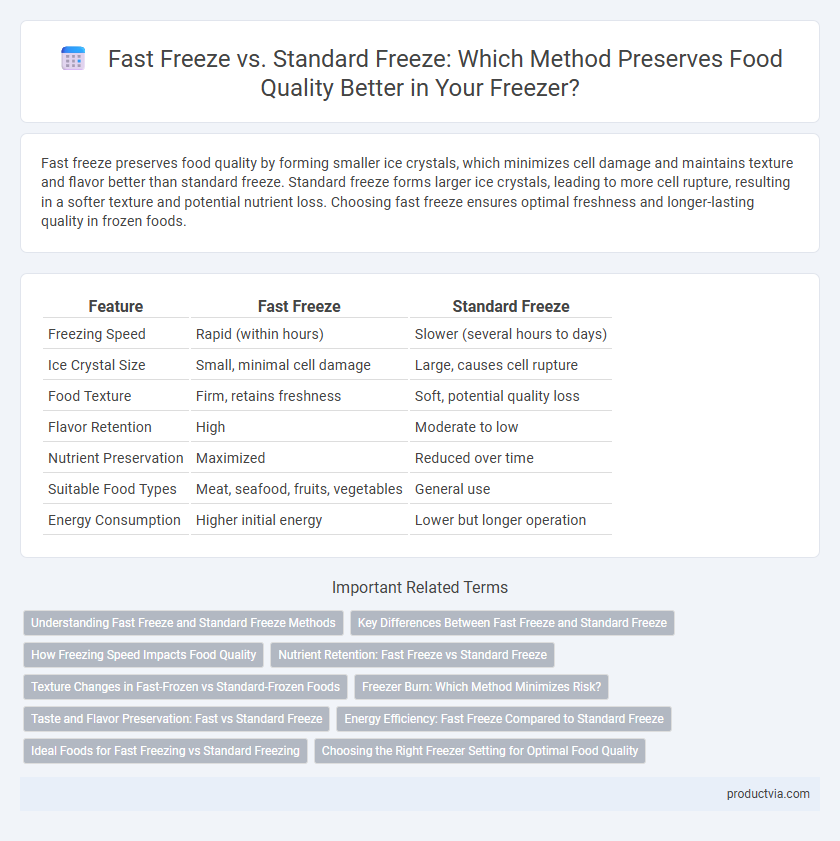Fast freeze preserves food quality by forming smaller ice crystals, which minimizes cell damage and maintains texture and flavor better than standard freeze. Standard freeze forms larger ice crystals, leading to more cell rupture, resulting in a softer texture and potential nutrient loss. Choosing fast freeze ensures optimal freshness and longer-lasting quality in frozen foods.
Table of Comparison
| Feature | Fast Freeze | Standard Freeze |
|---|---|---|
| Freezing Speed | Rapid (within hours) | Slower (several hours to days) |
| Ice Crystal Size | Small, minimal cell damage | Large, causes cell rupture |
| Food Texture | Firm, retains freshness | Soft, potential quality loss |
| Flavor Retention | High | Moderate to low |
| Nutrient Preservation | Maximized | Reduced over time |
| Suitable Food Types | Meat, seafood, fruits, vegetables | General use |
| Energy Consumption | Higher initial energy | Lower but longer operation |
Understanding Fast Freeze and Standard Freeze Methods
Fast freeze methods rapidly lower the temperature of food, typically reaching -18degC or below within minutes, which minimizes ice crystal formation and preserves cellular structure, texture, and nutritional value. Standard freeze techniques gradually reduce food temperature, often taking several hours and causing larger ice crystals that can damage cell walls and degrade food quality over time. Understanding the differences between fast freeze and standard freeze methods is essential for optimizing food preservation, flavor retention, and shelf life.
Key Differences Between Fast Freeze and Standard Freeze
Fast freezing rapidly lowers food temperature, forming smaller ice crystals that better preserve texture, flavor, and nutritional value compared to standard freezing. Standard freeze uses slower cooling, resulting in larger ice crystals that can damage cell structure and negatively impact food quality upon thawing. The key differences lie in freezing speed, ice crystal size, and the consequent effects on food texture and moisture retention.
How Freezing Speed Impacts Food Quality
Fast freeze technology rapidly lowers food temperature, forming smaller ice crystals that minimize cell damage and preserve texture, flavor, and nutritional value. Standard freeze methods cause larger ice crystals, leading to cellular ruptures which degrade food quality and result in moisture loss upon thawing. Faster freezing is crucial for maintaining the integrity of delicate foods such as fruits, fish, and baked goods, ensuring optimal freshness and shelf life.
Nutrient Retention: Fast Freeze vs Standard Freeze
Fast freeze technology preserves food nutrients more effectively by rapidly lowering temperatures, which minimizes ice crystal formation and cell damage. Standard freeze methods cause slower temperature decline, leading to larger ice crystals that rupture cell walls and degrade vitamins, especially vitamin C and B-complex. Nutrient retention rates in fast-frozen foods can be up to 30% higher compared to standard freezing techniques.
Texture Changes in Fast-Frozen vs Standard-Frozen Foods
Fast freeze technology preserves food texture by forming smaller ice crystals during rapid freezing, minimizing cellular damage and maintaining firmness. Standard freeze methods create larger ice crystals that rupture cell walls, often resulting in softer, mushier textures upon thawing. Texture integrity is significantly better in fast-frozen foods, making this method preferable for quality-sensitive items like fruits, vegetables, and seafood.
Freezer Burn: Which Method Minimizes Risk?
Fast freeze technology rapidly lowers the temperature of food, minimizing ice crystal formation that damages cell structures and reduces moisture loss, thereby significantly lowering the risk of freezer burn compared to standard freeze methods. Standard freezing allows slower ice crystal growth, increasing the likelihood of texture degradation and surface dehydration that leads to freezer burn. For optimal food quality preservation and minimal freezer burn, fast freezing methods are more effective.
Taste and Flavor Preservation: Fast vs Standard Freeze
Fast freeze technology rapidly lowers the temperature of food, creating smaller ice crystals that minimize cell damage and better preserve the taste and flavor. Standard freeze methods produce larger ice crystals that can rupture cell walls, leading to texture degradation and flavor loss over time. Maintaining optimal taste and flavor relies heavily on the freezing speed, with fast freezing offering superior sensory quality for frozen foods.
Energy Efficiency: Fast Freeze Compared to Standard Freeze
Fast freeze technology rapidly lowers food temperature, forming smaller ice crystals that preserve texture and nutrients better than standard freeze methods. This process, while consuming more energy in a short burst, can be more efficient overall by reducing storage time and minimizing food spoilage. Standard freezing uses less immediate power but may lead to higher cumulative energy costs due to longer freezing cycles and increased food degradation.
Ideal Foods for Fast Freezing vs Standard Freezing
Fast freezing preserves the texture and nutritional value of delicate foods like berries, seafood, and leafy greens by forming smaller ice crystals quickly, preventing cell damage. Standard freezing suits heartier items such as cooked meats, fruits, and vegetables that tolerate slower ice crystal formation without significant quality loss. Choosing the appropriate freezing method enhances food quality, extending shelf life while maintaining taste and texture integrity.
Choosing the Right Freezer Setting for Optimal Food Quality
Fast freeze technology rapidly lowers the temperature of food, preserving texture, flavor, and nutrients better than standard freeze methods that allow slower ice crystal formation, which can damage cell structures. Selecting the fast freeze setting minimizes drip loss and freezer burn, ensuring longer shelf life and improved taste upon thawing. For best food quality, especially with fresh produce and meats, using the fast freeze option maintains optimal preservation compared to standard freeze cycles.
Fast freeze vs Standard freeze for food quality Infographic

 productvia.com
productvia.com